The Writers Workbench
IFA Berlin 2016
Robert J. Elisberg
And it’s now…over. The IFA Berlin tech trade show has finally concluded, and as always it was a fascinating combination of tech and lunacy.
IFA is basically the European version of the Consumer Electronics Show. For several years, I’ve been describing the difference as being that CES is about the technology you’ll see in stores during the coming year, while IFA is about innovation. And to a degree that remains true, though I’ve noticed another, larger difference. CES is more about high tech—computers, the Internet, mobile, Smart-connected homes—and IFA has a focus more on home appliances. It most definitely presents all of these other things, too, but they don’t seem to be handled with the same prominence.
I tend not to write about home appliances all that much during the year, but at IFA it’s near-impossible not to. Not just because there’s so much of it there, but also because it truly is utterly absorbing. It’s not that there might be an intriguing refrigerator or washing machine here and there, but rather that any number of companies will each have their own massive lineups of enumerable vacuum cleaners and a wide range of cappuccino machines and several different irons and more. Things that we consider basic appliances, at IFA turn into a parade. It’s an iron, for instance, what on earth magical can you do with an iron? But at IFA, there might be half a dozen companies each with four or five irons so inventive that you need to go through Starfleet training to be able learn to use it.
They do love their irons, vacuum cleaners and cappuccino machines at IFA.
And so, this look at the show will be different from what I write about CES. It won’t be as much about discovering the little, remarkable tech devices as I roam the floors, but rather will give an indication of what kind of advanced products are out there for homes.
A few caveats to note up front.
IFA has a long history in Germany, going back to 1931 when it was a radio tech trade show. There remains a battle in IFA with one group wanting to keep that German focus and another competing side wanting to expand more to the world. While I understand the first group (this is their home, after all), if you want to be a world show, you have to be inviting to the world. And it’s not being xenophobic to say that 98% of the world in its distant corners speaks English, not German. As such, it’s sometimes difficult to find the special gems, because they’re well-hidden.
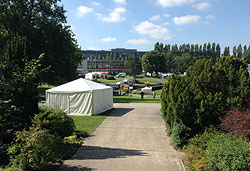 Also, IFA itself is convoluted. Fun, vibrant and interesting, but…sort of a mess. There are about 25 building you have to navigate over large grounds—appropriately named the Messe Fairgrounds. (Pronounced “messy.”) It’s not uncommon to have a hard time finding press conferences. Once, it took me 15 minutes to figure out how to get from the ground to the third floor. Another time, a group of reporters couldn’t find the door to get inside. Really.
Also, IFA itself is convoluted. Fun, vibrant and interesting, but…sort of a mess. There are about 25 building you have to navigate over large grounds—appropriately named the Messe Fairgrounds. (Pronounced “messy.”) It’s not uncommon to have a hard time finding press conferences. Once, it took me 15 minutes to figure out how to get from the ground to the third floor. Another time, a group of reporters couldn’t find the door to get inside. Really.
And then there is the German law that says if public grounds are used (which they are here), then the public must be admitted. That sounds lovely and inviting, but it turns a focused trade show into Macy’s the day after Thanksgiving. It is indeed charming and unique. It’s also an almost unmanageable jumble. And so most press and PR people are there for the pre-show press conferences and keynote speeches, and leave not long after the door officially open to the show. I still dive in and brave the floors, but it’s an otherworldly challenge.
There’s much more to write about the environment of the show, but for now, we’ll leave it at that. IFA is a pleasure, but a very odd fish.
And as always, I offer a warning ahead of time to readers that this will be long. Not cute long, but long. So for people who are intrigued by such things, welcome, buckle up, and jump aboard. If this is not for you, though, I understand, see you later, but don’t wander in and complain about how long this is. I know it’s long. I just told you…
That leaves one other important oddity about IFA, at least for those in the United States. It’s that not all the products presented there at the show will be on sale in the U.S. in the near future—and in some cases ever. But since they’re still interesting and point towards the future of tech (and, who knows?, the technology might be developed by other companies here), I feel it’s valid writing about them. Moreover, this is the World Wide Web, after all, so there are readers of these pages who live around the rest of that very same world. Wilkommen, bienvenue, welcome.
And one such product is the DuoDry from Haier. I’ve seem similar products, but not in an all-in-one, compact, integrated unit. This is one of those small, dual washer-dryers that you see in condos or homes with limited available space. Most of those are two separate products, one on top of the other, but these are built together…and with a clever twist. The top unit barrel is a 4kg washer, holding just under 9 pounds of laundry, while underneath the barrel is double the size at 8kg—but—it’s not just a dryer, rather it doubles as both a washer and a dryer together. You can do your washing, leave everything in the unit and it will then go ahead and do the drying, as well. It comes with a touchscreen that among other things shows Help videos, and a WiFi interface where you can set your laundry from on the road. In fact, you can set it to run the laundry at one time, and then do the drying hours later, so everything is nice and toasty when you get home. It will be on sale in Europe in September, 2017, for 1,800 Euros (about $1,900-2,000). As I said, there are no plans right now to sell it in the U.S., however Haier recently bought GE in June, so it’s possible those plans could change.
Another interesting innovation comes from the giant Bosch, which promotes the product as “Für jeden Anspruch dos perfecte Angebot.” (For every demand, the perfect offer, it says underneath in English.) Okay, to explain it more simply, the machine will run the “perfect dose” of detergent up to four loads. It can sense the load and knows how much soap to use automatically. (Why this machine particularly caught my eye is because of one oddity for an American passing by the display, where to be cutting edge it is promoted as “iDOS.” I had to do a double-take when reading that, since “DOS” is about as long-outdated a computer technology by about 20 years as one could have. It took me a few moments after reading through the various signage to realize that that was German for “dose.”)
On the dryer end of things, Miele has a new unit that interestingly uses steam drying, rather than just heat, as an alternative to ironing your laundry.
Why they would promote an alternative to ironing, though, is beyond me because at IFA, as I mentioned, ironing seems to be one of the continental sports of Europe. And an alternative to ironing seems almost sacrilegious. And not just the basic, little home irons you’re used to with a button to push for spray. No, we’re talking Space Age devices, for the Pro Leagues—yes, for an iron.
Years ago, I asked my grandmother (who’d been born in 1895) what invention during her lifetime, of everything there’s been, from jet travel to outer space exploration to television and cars, most impressed her. Her answer surprised me—the electric iron. But I learned a lesson from it. When she was a little girl, the iron was basically a slab of metal that you stuck in the fire until it was heated, and then you oh-so carefully grabbed for the handle and hoped you didn’t burn yourself…until it cooled off, and you repeated the process. Again and again. Until the next laundry. What her story made me realize is that the advances which most impress us at a personal level are the ones that most impact our daily lives, even if they’re not whizbang.
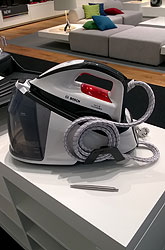 I can only imagine what she’d think about the development of electric irons today. For instance, a new iron from Bosch was so unlikely that I laid my pen down next to it so that you could get an idea of the size of this sucker. This is one REALLY BIG iron. And high-fangled and dazzling. An iron! I know there are people who dearly love ironing, but this might be a two-person job. So, find a friend and make it a group activity.
I can only imagine what she’d think about the development of electric irons today. For instance, a new iron from Bosch was so unlikely that I laid my pen down next to it so that you could get an idea of the size of this sucker. This is one REALLY BIG iron. And high-fangled and dazzling. An iron! I know there are people who dearly love ironing, but this might be a two-person job. So, find a friend and make it a group activity.
The Siemens Slider SLA7 does what most basic irons do, but in a more elaborate way. This had temperature settings for a range of different textiles, listed by fabric, not temperature. No guessing what the proper temperature should be with a dial. If you’re ironing cotton, set it for that and the temperature will change impressively in just a few seconds, and when it’s ready, a light goes on. No guessing or waiting necessary. Other settings were for wool, synthetic, linen, jeans and such. It doesn’t come cheap for such convenience, retailing at around 300-400 Euros, maybe $350-450.
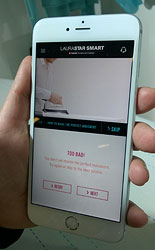 Then there’s the LauraSTAR, which is promoted as “the world’s first connected iron.” Now, I suspect most people don’t think there is a great need for a connected iron. After all, it's clearly not something you'd use by remote with Wi-Fi, ironing from afar. But there are certain semi-uses for it. Mainly, you download an app to your Smartphone, connect the iron settings to your app, and get help videos on the best way to best iron. (As someone who isn’t great at ironing, I can accept that there are “best ways,” though worst ways does tend to get the job done, eventually.) For example, if you're doing it inefficiently, sensors in the iron will inform the app, and the screen will correct you. You can set steam adjustments with the app and also get cleaning maintenance updates. I quipped that they could also display how many calories you were using and make it sort of a game, and the rep not only laughed but actually liked the suggestion and said she'd pass it along. Hey, as long as you’ve already got the app, why not? But I do suspect that most people who iron a lot, and would want to pay a price for an iron, don’t need “how to” videos. Besides, the hot slab of metal worked okay 100 years ago. But, hey, it’s an advance so Godspeed.
Then there’s the LauraSTAR, which is promoted as “the world’s first connected iron.” Now, I suspect most people don’t think there is a great need for a connected iron. After all, it's clearly not something you'd use by remote with Wi-Fi, ironing from afar. But there are certain semi-uses for it. Mainly, you download an app to your Smartphone, connect the iron settings to your app, and get help videos on the best way to best iron. (As someone who isn’t great at ironing, I can accept that there are “best ways,” though worst ways does tend to get the job done, eventually.) For example, if you're doing it inefficiently, sensors in the iron will inform the app, and the screen will correct you. You can set steam adjustments with the app and also get cleaning maintenance updates. I quipped that they could also display how many calories you were using and make it sort of a game, and the rep not only laughed but actually liked the suggestion and said she'd pass it along. Hey, as long as you’ve already got the app, why not? But I do suspect that most people who iron a lot, and would want to pay a price for an iron, don’t need “how to” videos. Besides, the hot slab of metal worked okay 100 years ago. But, hey, it’s an advance so Godspeed.
Another of the product lines that, for somewhat inexplicable reasons (to me) is so massively popular at IFA are vacuum cleaners. Definitely high-tech, and a wide range of models within companies. Furthermore, demonstrations for vacuuming seems like a competitive sport.
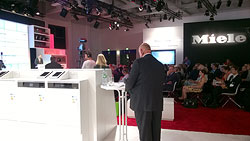 Miele heavily promoted their interesting “bagless” vacuum, the Blizzard CX-1. Because the press conference was in German, I missed some of the explanation of how on earth this works. The best I could make of it was that there are highly advanced filtration units inside that act as dust containers, and that fine dust and coarse dust are separated. You also never need to have any contact with dust and never even have to replace the filter, which is lifetime guaranteed and has a very high A- HEPA rating. And no, I don’t know what a HEPA rating is. It seems to be a European thing, and people were suitably impressed. About halfway through the event, I happily realized that they had a few headset translation devices available, so I was able to get a bit up to speed on all this. (I saw a Miele official off to the side and almost interrupted him, asking for assistance. I’m glad I didn’t, though, since he was the person reading from a script, doing the live translating.)
Miele heavily promoted their interesting “bagless” vacuum, the Blizzard CX-1. Because the press conference was in German, I missed some of the explanation of how on earth this works. The best I could make of it was that there are highly advanced filtration units inside that act as dust containers, and that fine dust and coarse dust are separated. You also never need to have any contact with dust and never even have to replace the filter, which is lifetime guaranteed and has a very high A- HEPA rating. And no, I don’t know what a HEPA rating is. It seems to be a European thing, and people were suitably impressed. About halfway through the event, I happily realized that they had a few headset translation devices available, so I was able to get a bit up to speed on all this. (I saw a Miele official off to the side and almost interrupted him, asking for assistance. I’m glad I didn’t, though, since he was the person reading from a script, doing the live translating.)
Vacuums were everywhere, from a panoply of companies that are notable overseas but just names to me as I passed them. One company, Vax—okay, that’s a bit of a giveaway what they focus on—carried a line of 10 different models of vacuum cleaners. Another, K’Archer, was introducing its Revolutionary 2-in-1 Floor Cleaner. I did try to determine what was revolutionary about it—it seemed like it had a pretty basic roller—but never could figure it out. And of course, among the Big Names, there was Bosch with its oddly named Relaxx’x vacuum. (No, that’s not a typo.) This was controlled by a Smart Sensor floor control, which meant little to me, though I’ll take them at their word that it works better. What did stand out is how impressively quiet it was.
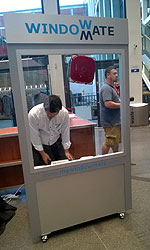 One thing related to this was a kind of product I’ve seen introduced recently, but it appears to be a growing market, since there were more of them. They were like the iRobot device that has become somewhat popular, the disk-like unit that roams around your floor vacuuming on its own. These new devices do the same thing…but for your windows. Holding onto the glass in some way and then rolling up-and-down as it cleans. Neato, which is another of the many companies making vacuums with demonstrations, had a model, as did another company called WindowMate.
One thing related to this was a kind of product I’ve seen introduced recently, but it appears to be a growing market, since there were more of them. They were like the iRobot device that has become somewhat popular, the disk-like unit that roams around your floor vacuuming on its own. These new devices do the same thing…but for your windows. Holding onto the glass in some way and then rolling up-and-down as it cleans. Neato, which is another of the many companies making vacuums with demonstrations, had a model, as did another company called WindowMate.
It is cappuccino machines, though, which really seem to be the art form of IFA. I can only presume that Europeans dearly love their coffee. And love it to extremes where only the most exquisitely designed high-tech devices will suffice. You walk through a company’s exhibit, and it’s like crossing a poppy field in Coffee Heaven. No paltry one-drip devices here, these are for those who take their coffee as seriously as jet pilots take their cockpit.
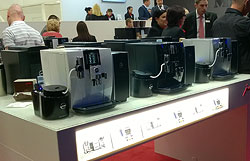 Juka had what seemed like 15 separate models. The jungle that was Nespresso offered nearly 100 (although the company seemed more like a distributer of numerous brands, not a manufacturer—but that there are that many for just one distributer is amazing alone). Miele had a dozen or so models, the most intricate allowing for 20 settings: long black, flat white, café au lait, ristretto, kaffe lang, espresso macchiato, cappuccino Italiano and on and on and pour on. That one unit alone puts even Starbucks to shame.
Juka had what seemed like 15 separate models. The jungle that was Nespresso offered nearly 100 (although the company seemed more like a distributer of numerous brands, not a manufacturer—but that there are that many for just one distributer is amazing alone). Miele had a dozen or so models, the most intricate allowing for 20 settings: long black, flat white, café au lait, ristretto, kaffe lang, espresso macchiato, cappuccino Italiano and on and on and pour on. That one unit alone puts even Starbucks to shame.
When I mentioned earlier about how there are many home appliances at IFA that haven’t hit the U.S. market, and may not, one of the most egregious is something I’ve written about for five years—induction stoves. The best way to describe these is that they’re electric stoves—elegant, smooth, impeccably clean lines, no knobs, just push button icons like on a tablet—that use a technology which only heats metal. So, you could put on a skillet, heat it up and grill a steak…and remove the pan, touch underneath, and it would be perfectly cool. It’s remarkable. And IFA has had set-ups that are sort of all-in-one kitchen/dining room designs where you can cook and eat on the same appliance. But…they’re still not available in the United States.
(Actually that’s not completely true. They can be found, but they’re much more expensive than in Europe because a good deal of remodeling and rewiring is needed in a home. I heard an explanation, and it has to do with the power requirements for the technology. It’s the standard in Europe, but needs to be converted over here.)
What is being developed for stoves goes even beyond this. Bosch announced its Air Quality Detector which is built into the grill cover of stoves. It certainly sounds offbeat, but they say it will detect water vapor and aromas (!) to impact what’s needed during the cooking process.
The company also tackled a long-held issue with gas stoves, which always have had one disadvantage compared to electric units when it comes to temperature accuracy, since adjusting flames is so tricky. They have new gas stoves, however, that provide nine levels of flame control.
Appliances as basic as the refrigerator have also had a tech-growth spurt. For the past year or two, refrigerators have begun to join the “connected” world, with cameras and WiFi capability where you can check on what’s inside from afar. The capabilities have grown, with one refrigerator from Gorenje (a Slovenian company) announcing its odd, but interesting Fridge Freezer. This has a lower freezer compartment that lets you set a timer so you can slowly defrost what’s inside and it will be ready to go when you need it, like in the morning or for preparing dinner. It also has a “vita light,” which is always on and apparently allows fruit to stay fresher since this duplicates the natural sunlight fruit thrives under. Okay, honestly, I’m not sure if either of these technologies strike me as essential, but it’s always intriguing to see what they come up with.
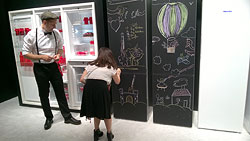 Interestingly, my favorite new refrigerator design was as low-tech as they come. After seeing for generations little children play with the front of refrigerators and draw on them and smudge them, Miele came up with a design for which the front is not the traditional white, but rather…an actual blackboard! Not only can kids go wild on it with no downside, but you can jot down your messages directly on the board.
Interestingly, my favorite new refrigerator design was as low-tech as they come. After seeing for generations little children play with the front of refrigerators and draw on them and smudge them, Miele came up with a design for which the front is not the traditional white, but rather…an actual blackboard! Not only can kids go wild on it with no downside, but you can jot down your messages directly on the board.
And Bosch has an entire environment for connecting home appliances with remote control that seem to go beyond the standard connected Smart homes. Each sensor for the refrigerator and oven and dishwasher and other home appliances can communicate with one another, and not just with Bosch products, but involving partnerships that also integrate with them, like with Philips.
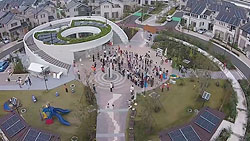 Indeed, “connected homes” continues to be one of the biggest area of tech development growth. Panasonic has been pushing this especially hard for the last few years, most notably with its Smart Cities project, where they have developed literally fully-contained towns, like Fujisawa—which they call a “Sustainable Smart Town”—as a blueprint to study areas like connectivity, mobility, energy consumption, security, health care and much more. (In some ways, this is a cousin to what Walt Disney initially wanted to create with EPCOT, which stood for Environmental Prototypical Community of Tomorrow.) They’re also working with cities around the world on a more focused, limited basis, including creating a solar grid to provide backup power for a light rail system in Denver. And a “Future Living Project” there in Berlin.
Indeed, “connected homes” continues to be one of the biggest area of tech development growth. Panasonic has been pushing this especially hard for the last few years, most notably with its Smart Cities project, where they have developed literally fully-contained towns, like Fujisawa—which they call a “Sustainable Smart Town”—as a blueprint to study areas like connectivity, mobility, energy consumption, security, health care and much more. (In some ways, this is a cousin to what Walt Disney initially wanted to create with EPCOT, which stood for Environmental Prototypical Community of Tomorrow.) They’re also working with cities around the world on a more focused, limited basis, including creating a solar grid to provide backup power for a light rail system in Denver. And a “Future Living Project” there in Berlin.
By the way, good news—we're well-past the halfway mark now, o huzzah!, so the end is actually reasonably in sight...
Clearly, most things at the show were not on such a Grand Scale as connected Smart cities. And IFA was full of its share of smaller tech products intended to hopefully make advances and improvements in a person’s everyday life.
Acer partnered with a social company called Comfort Keeper to introduce the Grand Pad (a twist on “grandpa”). It’s a sort of interesting tablet-like device for the elderly who aren’t that adept with technology and also feel largely cut off for the world. It provides a simplified means for social interaction, staying in touch with family, and listening to music from one’s own era, among other features. Sort of a way to connect with the world.
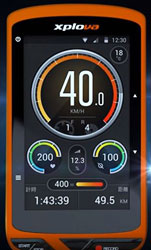 The company also had one of the more useful fitness devices I’ve come across. I tend to find them a bit one-trick-pony limited in their design, but Acer’s Xplova X5 (which has been out for a few months) put together quite a few nice features for what seems on the surface a route GPS for cyclists. But it also has a means to track your heart rate, the ability to check your pedaling speed, as well as your pedal cadence, and (probably the core of the device) a video camera to capture your trip—connected to your bike, rather than wearing it on your helmet—with the ability to set it to automatically record things like when you hit pre-set speeds, or when your heart rate reaches a certain level, or you pass by a specific GPS coordinate (where there are recognizable landmarks), as well as an app to keep you in touch with others in your riding group and share your videos during the ride, and more.
The company also had one of the more useful fitness devices I’ve come across. I tend to find them a bit one-trick-pony limited in their design, but Acer’s Xplova X5 (which has been out for a few months) put together quite a few nice features for what seems on the surface a route GPS for cyclists. But it also has a means to track your heart rate, the ability to check your pedaling speed, as well as your pedal cadence, and (probably the core of the device) a video camera to capture your trip—connected to your bike, rather than wearing it on your helmet—with the ability to set it to automatically record things like when you hit pre-set speeds, or when your heart rate reaches a certain level, or you pass by a specific GPS coordinate (where there are recognizable landmarks), as well as an app to keep you in touch with others in your riding group and share your videos during the ride, and more.
Speaking of cameras, one of the more odd events at IFA concerned one that is part of a new phone being introduced, the Nova Plus, by Huawei (pronounced Whah-way), a Chinese company you may not have heard of but that’s number three in sales in the world. The 5.5” large-display phone looks quite nice, with solid specs, including a long-life battery, and sitting at a price range of 429 Euros (probably retailing in the mid-$400 range in the U.S. Less than most flagship phones, but above entry-level models.)
But it was the press conference that caught so much attention—not only there in Berlin outside the fairgrounds at the distant, hard-to-get-to Velodrome, but streaming online and Twitter.
The highlight -- without question the highlight (because Twitter later went crazy over this part, from all the tech reporters tweeting about it)—came when, with great fanfare, they brought out a very popular "fashion influencer" named Xenia Tchoumi to help promote the phone. Ms. Tchoumi, who is a lovely young woman, which most people with me presumed was a large part of the reason she was so popular, since not much of what she said was anything more than bizarrely surface in ways that might make your head explode, then preceded to spend the next 15 minutes to explain all about how truly great this new phone is for… well, taking selfies. I swear to you. I am not remotely exaggerating. Selfies. For 15 minutes. My personal favorite moment was when she said, "Like everyone, the first thing I do in the morning is take a selfie of my breakfast." (Again, really. That's not a joke.) Mind you, I generally don’t even have breakfast, so it isn’t the first thing I myself do, but who knows, your mileage may vary, every day. But it was perhaps at about five minutes in when she reached her pinnacle, explaining in full, relentless detail about all the great benefits of what you can do when you’re at a fashion show with taking selfies and getting your make-up perfect and your skin tones just right and—okay, keep in mind here that the crowd of 500 techies was largely male, mostly card-carrying geeks, and slovenly dressed in rock band t-shirts and sloppy pants—and how taking a selfie of a shoe might be the most important thing in fashion today, or maybe, no, maybe the most important thing in fashion today is just people walking around at a fashion show and here are pictures of some selfies she's taken at fashion shows, "One-handed selfies," she called them, one-handed selfies taken with the Nova Plus that was so easy to do with one hand thanks to a well-placed button on the back to take your one-handed selfies. It was at this point that a colleague, tech journalist Dan Tynan, sent a text message that got passed around due to its pointed, subtle phrasing albeit a tad crude, explaining that in his day, doing a one-handed selfie went by a different name.
Keep in mind, too, that this quarter-hour Homage to the Selfie was ultimately for a phone. But don’t take my word for it, click here for the video of the whole thing. All 15 glorious minutes. Fast-forwarding allowed.
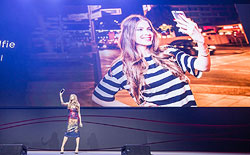 As I said, when the tech journalist present began tweeting in amazement about this, social media lit up. To be fair to Miss Xenia, I believe she said she was live-streaming her presentation to her followers (which are a great many—they said a million), so I assume she was largely addressing them, not the fashion-challenged male crowd who were actually present. And so it probably did get a good deal of attention. But still, this was a press event, and even her followers weren't likely going to use the Nova Plus to take selfies of themselves at fashion shows. It was not the greatest planning by Huawei as a way to promote their otherwise quite-solid, good-looking phone.
As I said, when the tech journalist present began tweeting in amazement about this, social media lit up. To be fair to Miss Xenia, I believe she said she was live-streaming her presentation to her followers (which are a great many—they said a million), so I assume she was largely addressing them, not the fashion-challenged male crowd who were actually present. And so it probably did get a good deal of attention. But still, this was a press event, and even her followers weren't likely going to use the Nova Plus to take selfies of themselves at fashion shows. It was not the greatest planning by Huawei as a way to promote their otherwise quite-solid, good-looking phone.
Perhaps the opposite of the selfie, I finally had my first, albeit brief test of a Virtual Reality headset, the Samsung Gear VR. The video playing when I had the device on was of skydiving, and it was certainly very effective, giving a vibrant sense of the freefall activity. The technology certainly has a future, though it’s not the New Big Thing yet, despite some of the press expressing this for the past couple of years. What the application will be—mostly games, or expanded beyond that for practical use—remains to be seen.
And while at the Samsung booth, I’m happy to note that no Galaxy Note phones exploded when I was there. And yes, that is today’s cheap shot. (But seriously, when the government tells everyone to turn your company’s phones off, and all airlines start checking to make sure you don’t have the phone turned on in their plane, this is not A Good Thing…)
And, of course, since this is a tech trade show, I can’t let the entire IFA go by without mention of computers. As I mentioned at the beginning, that’s a very small part of the exhibition, but it does exist, and a few things seemed interesting.
 Acer had an extremely thin 2-in-1 convertible laptop, the Swift 7. This is first laptop (they say…) that’s less than a centimeter—which works out to just .4 inches. It has a 13.3” screen, seventh generation Core i-series processor, and very nicely designed aluminum body in gold and black, weighing in at just 2.5 pounds. Its touchscreen swivels 360-degrees. The Swift 7 should retail at around $1,000.
Acer had an extremely thin 2-in-1 convertible laptop, the Swift 7. This is first laptop (they say…) that’s less than a centimeter—which works out to just .4 inches. It has a 13.3” screen, seventh generation Core i-series processor, and very nicely designed aluminum body in gold and black, weighing in at just 2.5 pounds. Its touchscreen swivels 360-degrees. The Swift 7 should retail at around $1,000.
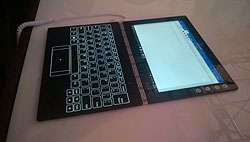 And Lenovo has an interesting oddity, the Yoga Book. This is a 2-in-1 tablet—coming in either Windows or Android—with a 10” screen about the size of a large book, and a cover that allows you to type on its Halo “touch-sensitive” keyboard that only appears when needed. (These aren’t physical keys, but graphic images, so there’s zero travel or “feel” to them. And yes, the key images do “magically” appear on the black surface when you’re in typing mode.) I tested it, and the keyboard was awful for serious typing but fine for hunt-and-peck note taking. Also, you can draw it or take notes using their Real Pen on regular paper, and the images will show up on screen. It all weighs just 1.5 pounds. Depending on the model, it will retail for between 450-550 Euros. (From what I can tell, it appears that this might work out to about the same in dollars when it hits the U.S.)
And Lenovo has an interesting oddity, the Yoga Book. This is a 2-in-1 tablet—coming in either Windows or Android—with a 10” screen about the size of a large book, and a cover that allows you to type on its Halo “touch-sensitive” keyboard that only appears when needed. (These aren’t physical keys, but graphic images, so there’s zero travel or “feel” to them. And yes, the key images do “magically” appear on the black surface when you’re in typing mode.) I tested it, and the keyboard was awful for serious typing but fine for hunt-and-peck note taking. Also, you can draw it or take notes using their Real Pen on regular paper, and the images will show up on screen. It all weighs just 1.5 pounds. Depending on the model, it will retail for between 450-550 Euros. (From what I can tell, it appears that this might work out to about the same in dollars when it hits the U.S.)
Speaking of turning your handwritten notes into digital, I ran again into Wacom’s Bamboo Spark (whose name I still don’t grasp...) which somewhat similarly converts your handwritten text or notes to digital. Unlike other like-products in the past, the Bamboo Spark can work with any normal paper. The product is a folio with a placeholder on the left side for your tablet or Smartphone, and a digitizer pen, and your paper sits on the right. Basically — press a button, write, and press the button again when you’re finished. If your tablet is connected, it will transfer the converted digitized content immediately. If your tablet/phone isn’t connected, the pen will save the content until you do connect. I’ve done some tests with it back at home—even using simple scraps of paper—and it took a little getting used to, but ultimately worked well and fairly simply. There’s also a cloud-based feature for the transferring of material. My sense is that it’s most effective for short note-taking, rather than writing out long treatises. It’s certainly much less versatile than Lenovo’s Yoga Book, but the retail price is also much less, only $129.
And in the end—yes, we’re almost there—what would a tech trade show be without an award winner for the oddest product on display? Now, to be clear, there is always a lot of oddity at a tech show. That’s the nature of the beast. But every once in a while something leaps out that has me scratching my head, in a “What were they thinking” kind of way. And this year, the Odd Award goes to one of the simplest devices I came across. And from a good, well-known and perfectly rational company, no less: Logitech. It’s their "Silent Mouse." Now, mind you, I've never considered a mouse a particularly noisy item. Mine at home does make a sound, albeit a nearly imperceptible click. I can't tell you how silent this Silent Mouse is, though, since the show floor was so noisy that I couldn't hear much of anything. Of course, it might be wonderfully silent, gloriously. And there might well be computer work where people do need total silence from their mouse. But a mouse just doesn't strike me as an area of technology that has a major need and is crying out for a resolution.
And with that, we come to the end of the fascinating, vibrant, and odd IFA Berlin tech trade show. And when discussing silence, what better place to end with what is always perhaps my favorite image of the show.
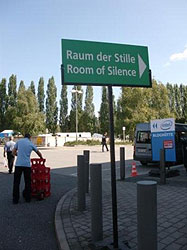
Auf wiedersehen.
Note: The Writers Guild of America West neither implicitly nor explicitly endorses opinions or attitudes expressed in this article.
Copyright 2016, Robert J. Elisberg. All rights reserved.
Robert J. Elisberg's new novel The Wild Roses, a comic adventure in the spirit of The Three Musketeers but with three women, is now available here in paperback or for $3.99 as a Kindle eBook. His other political and tech writing can be found at Elisberg Industries.
